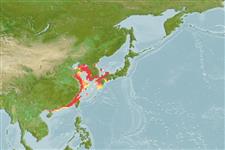Environment: milieu / climate zone / depth range / distribution range
ນິເວດວິທະຍາ
ສັດທະເລ; ນ້ຳຈືດ; ນ້ຳກ່ອຍ; ປາທີ່ມີການເຄື່ອນຍ້າຍຈາກທະເລ ແລະ ໄປໄຂ່ຢູ່ນ້ຳຈືດ (Ref. 51243); ລະດັບຄວາມເລິກ 0 - 50 m (Ref. 189). Subtropical; 42°N - 21°N, 109°E - 134°E (Ref. 189)
Northwest Pacific: Canton north to Ariake Sound, southwestern Japan, including all of Yellow Sea and off western coasts of Korea. Penetrates over 1000 km up the Yangtze River.
Length at first maturity / ຂະໜາດ / ນ້ຳໜັກ / Age
Maturity: Lm ?, range 24 - 27 cm
Max length : 41.0 cm TL ຕົວຜູ້/ບໍ່ມີເພດ; (Ref. 189)
ຄີ (ໜາມ)ແຂງຢູ່ຫຼັງປາ (ທັງໝົດ): 0; ຄີ(ໜາມ) ແຂງຢູ່ຄີກົ້ນປາ
ກຸ່ມປາກະດູກແຂງ
ຄວາມຖີ່ຂອງກຸ່ມຖ່າຍທອດພັນ
ປາທີ່ມີການເຄື່ອນຍ້າຍຈາກທະເລໄປຫານ້ຳຈືດ ແລະນ້ຳຈືດຫາທະເລ
ປາທີ່ມີການເຄື່ອນຍ້າຍຈາກທະເລແລະໄປໄຂ່ຢູ່ນ້ຳຈືດ
ຄີກົ້ນຂອງປາ
ສັດທີ່ມີກະດູກສັນຫັຼງ
ການຖ່າຍທອດທາງກຳມະພັນຈາກພໍ່ແມ່ຫາລູກ 0; ຄີກົ້ນຂອງປາ: 80. Body tapering, belly rounded before pelvic fins, with 16 to 26 + 25 to 36 = 43 to 61 keeled scutes from isthmus to anus. Maxilla long, reaching to or almost to base of first pectoral fin ray. Pectoral fin with 6 filaments; branched fin rays longer than those of pelvic fin.
Occurs in coastal waters, estuaries and reaching up to middle parts of rivers, apparently able to tolerate freshwater (Ref. 189, 11230). Lives in not really clean water but not really turbid water either (Ref. 12218). Goes to the deep water areas of rivers at night (Ref. 12218). Planktivore (Ref. 12218). Spawns around three times in a lifetime and spawning occurs in between reeds (Ref. 12218). In Ariake Sound, Japan it breeds from May to August, the fishes running about 15 km up the Chikugo River and spawning in freshwater, the spherical eggs floating down and hatching near the river mouth. Its relatively large size makes it a more esteemed food fish than most Coilia. Used in Chinese medicine (Ref. 12166).
Spawn in school (Ref. 205).
Whitehead, P.J.P., G.J. Nelson and T. Wongratana, 1988. FAO Species Catalogue. Vol. 7. Clupeoid fishes of the world (Suborder Clupeoidei). An annotated and illustrated catalogue of the herrings, sardines, pilchards, sprats, shads, anchovies and wolf-herrings. FAO Fish. Synop. 125(7/2):305-579. Rome: FAO. (Ref. 189)
IUCN Red List Status (Ref. 130435)
Threat to humans
Harmless
Human uses
ການປະມົງ: ເປັນສີນຄ້າ
ຂໍ້ມູນຕື່ມອີກ
ເອກະສານອ້າງອີງການລ້ຽງສັດນ້ຳຂໍ້ມູນການລ້ຽງສັດນ້ຳສາຍພັນກຳມະພັນElectrophoresesການຖ່າຍທອດທາງກຳມະພັນຈາກພໍ່ແມ່ຫາລູກພະຍາດການປຸງແຕ່ງNutrientsMass conversion
ຜູ້ຮ່ວມມືຮູບStamps, Coins Misc.ສຽງຫອຍມີພິດຊະນິດນຶ່ງທີ່ອາໄສໃນທະເລຄວາມໄວປະເພດການລອຍເນື້ອທີ່ເຫືອກOtolithsສະໝອງວິໄສທັດ
ເຄື່ອງມື
Special reports
Download XML
ແຫຼ່ງອີນເຕີເນັດ
Estimates based on models
Preferred temperature (Ref.
123201): 12.3 - 25.2, mean 17.5 °C (based on 218 cells).
Phylogenetic diversity index (Ref.
82804): PD
50 = 0.5001 [Uniqueness, from 0.5 = low to 2.0 = high].
Bayesian length-weight: a=0.00251 (0.00190 - 0.00332), b=3.07 (3.02 - 3.12), in cm total length, based on LWR estimates for this species (Ref.
93245).
ຊັ້ນເຂດຮ້ອນ (Ref.
69278): 3.0 ±0.00 se; based on food items.
Generation time: 3.1 ( na - na) years. Estimated as median ln(3)/K based on 2
growth studies.
ຄວາມຢືດຢຸ່ນ (Ref.
120179): ຂະໜາດກາງ, ປະຊາກອນຕຳ່ສຸດທີ່ໃຊ້ເວລາສອງເທົ່າ 1.4 - 4.4 ປີ (K=0.35; tmax=5).
Fishing Vulnerability (Ref.
59153): Low to moderate vulnerability (25 of 100).
